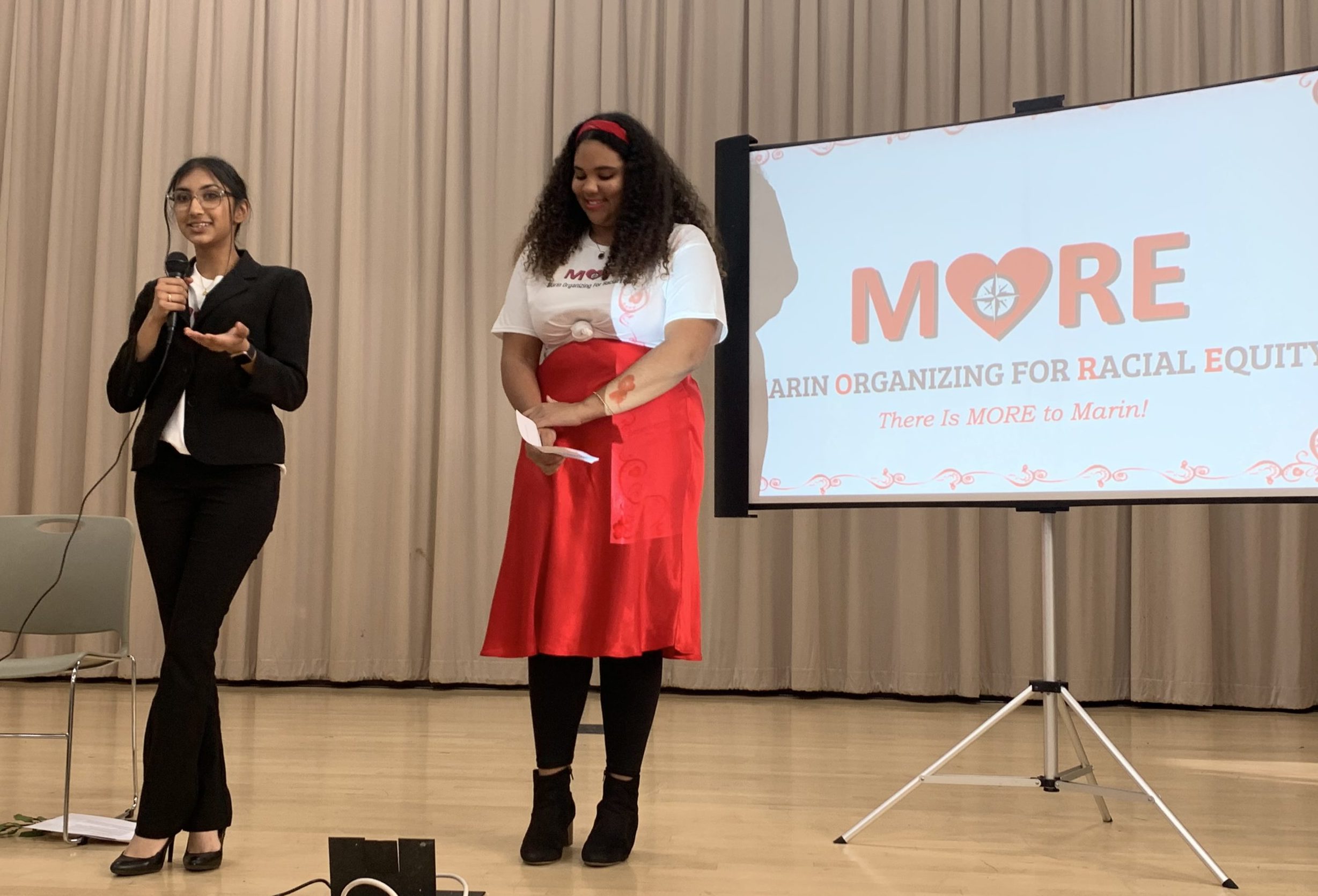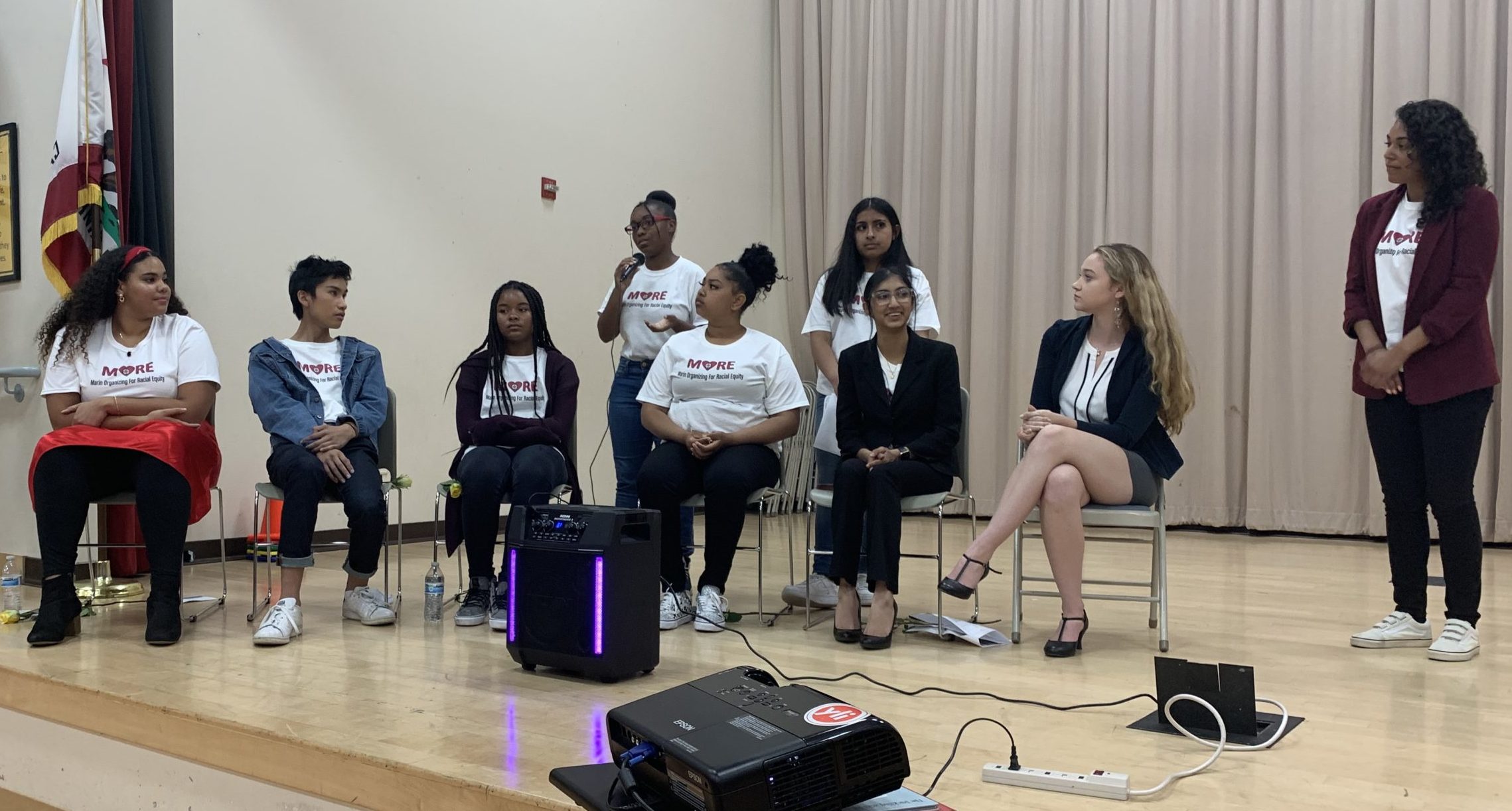
It all started about a year ago in April of 2019. My friend Jay had joined Marin Organizing for Racial Equity (MORE) at yli, and she kept bugging me to come to a meeting. “Fine! Alright! I’ll go!” I sat back and just listened at the first meeting. I didn’t know what this was all about. At the time, I didn’t even know what “equity” meant. The only person I knew there was Jay, and I didn’t feel like looking at people in the face, let alone talking.
But as the other students began to tell their stories, I was like, “Hold on, I went through that.” A lot of things have happened to me that I didn’t know were “real” – I didn’t know they were “a thing,” and that other people have experienced them, too.
One of the stories that resonated with me was around pushing my culture away. In elementary school, I used to come to class in culture clothes and bring food from home, but people thought it was weird and would tease me: “That smells,” or “Why are you wearing that?” The music I listened to wasn’t what the other students listened to. I didn’t know movies, actors, musicians. They’d be listening to Rhianna and Katie Perry. I was into Bollywood. “Where have you been, under a rock with Patrick?” they’d say. “You’re living in America.”
I took offense to it, but I decided to find ways to fit in. I became distant from my culture – I tried to Americanize myself. At home, I could be me but at school I couldn’t be Indian – there was nothing of me around me.
A step between two worlds
It always felt like a conflict – a step between two worlds. When I got to high school, I made new friends, and that changed everything. One time, I brought leftovers to school and a new friend said, “Oh my god, can I have some? It’s so good!” That felt good. The clothes people used to think were weird, were now beautiful to my new friends. Looking back, there weren’t a lot of people of color in my elementary and middle schools – just my cousin and myself. Now, all of my friends are Black and people of color. It’s like two cultures coming together: my friends bring from theirs and I bring from my culture. I bring more home food, I’m more open about what holidays I celebrate, what I wear to weddings. There aren’t any “ewwwws” or, “That’s nasty.” My friends are accepting. We take the best of each of our cultures and mix our styles.
But being in a majority white area is still uncomfortable. Walking home after school at 6:30pm I get funny looks like, “do you know where you’re going?” I’ve lived here for the majority of my life, but people ask me where I’m from. I still don’t belong where I live.
So when I heard those stories being shared at the MORE meetings, I started looking up. I thought it was going to be all business, but they were talking about life and how their experiences are connected to what we’re doing in the program. I started talking a little bit. Each meeting, I’d talk a little more.
Then I started thinking: if it happens to these individuals in this room, imagine what happens at the school, in the community. There are others who look like me who are going through this, too, so it’s important to get out of my skin and speak up. There aren’t a lot of staff or teachers of color where I go to school at Tamalpais High. A few years ago at Redwood High School, someone spray painted a racial slur with the principal’s name on a big crystal ball. Then, just last year, there was an incident at a rally where a group of white girls wore reggae hats with fake dreads to perform. People took offense, but there were no conversations, no consequences, and that allows these actions to be repeated.
Where change starts
Starting in March, the MORE youth will be conducting a survey across the school district. There will be questions about how youth identify in terms of race and gender, and if they feel safe and supported at school, along with other questions. We’ll also be doing focus groups to get deeper with youth of color. We want to find out what they need to feel more supported and what they want to change. We plan on presenting our findings to the county to let people know where the school district is at in terms of racial equity. We’ll also be creating an action plan for the future based on the stories shared by the students. We’re not trying to point fingers, but we do want to ensure that we can make a change.
This is where change starts – with stories and real life experiences. Stories are interesting…and real. For me to open up, I had to listen to someone else open up first. I had to know that they could carry the weight of what was going on in my heart. The stories really made me reflect on my own life, what was really happening to me, and how far it all went back. If I had been this aware of what was happening to me in elementary school, it would have been different. I wouldn’t have needed those people to fit in. I would have felt good in my own skin and culture.
For people who haven’t had those experiences, they can learn what we go through as youth. But these stories can only make a difference if the people who are listening have the power to make a change. I felt that at the MORE Launch event we did last year at the Martin Luther King, Jr. Academy last October. When we were done with our presentation, administrators and teachers rushed up to grab the mic. They were so moved by our stories, which reminded them of their own experiences decades ago. They didn’t realize that we’re still going through all this. We say a lot of things are over but they aren’t. They are just coded differently.

I’ve been going to the MORE program every Wednesday, and it has taught me how to stand up for racial equity and equality. It’s given me a chance to learn how to use my voice, grow into my own skin, know myself. It’s taught me about my leadership style: I want to get at what everyone wants first. I get inspired by the ideas of others – I listen first, then speak. Maybe our experiences are similar, maybe we’re thinking the same thing, just in a different way. We can puzzle together, collaborate. By being this type of leader, I hope that I can inspire and help others in any way possible.
The program is more than a community – we all resonate with each other. The space is not all seriousness. It’s not all just about getting work done. We start every meeting with check-ins, we talk about what we’re looking forward to. We give each other advice and we’re there for each other. There’s a lot of sympathy and empathy, like a family. We all hang out before yli – we go to the mall, we walk around. We’re building on what we have at the meetings outside of the meetings. The feeling is, “I trust you in this room and also outside of this room.” We need this strength and trust with each other, or else we won’t make it.
I feel really driven to make change by my brother, who is 6 years old right now. He’ll be in high school in 10 years. He’s growing up in the same schools, under the same conditions, and I don’t want him to push his culture away like I did. I want to set an example now, make school better for him now, so he won’t have to deal with that when he gets here. I started an excellence club at my high school. It’s a safe space, but also a place to build pride for students of color.
Looking ahead
Looking ahead to the future, I’m still kind of lost – I don’t know yet. I really love art and working on racial equity. I taught myself how to draw what I see in the world. If I’m drawing a person, I leave the eyes empty, with dramatic eyelashes – that’s where the soul lies. The invitation is, what do you see in their eyes? I don’t know what’s inside you – you see what you want to see. You’re not going to see the same thing I see. I think these are the biggest pictures I can paint. I believe that you have to project your story in any way you can – if you can’t say your story, then sing your story, draw your story. If we tell a good story, others will want to be in the picture we’re painting.
